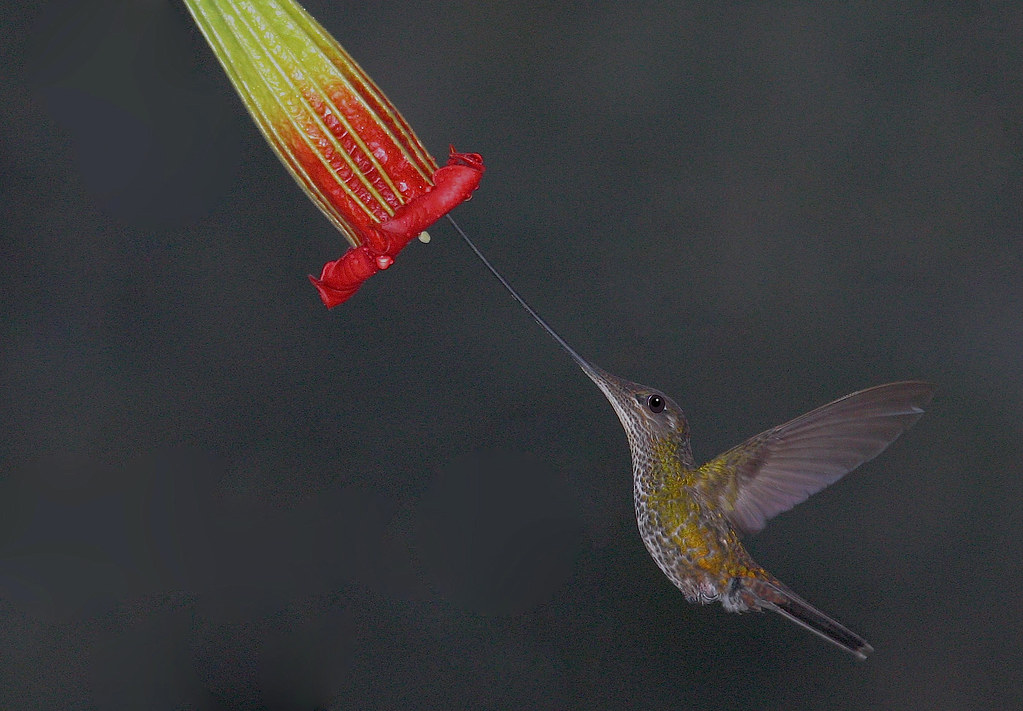Pollinator Week was June 21-27, 2021.
Birds are key global pollinators of wildflowers and ornithophily (bird pollination) occurs in more than 60 flower families. Bird pollinators include the orioles and hummingbirds of the New World, honeycreepers of Hawaii and central and South America, sunbirds of Africa, and the lorikeets and honeyeaters of the Australasian realm.
Hummingbirds are perhaps the most familiar and include the smallest bird in the world, the Bee Hummingbird, at .06 oz and two inches in length. Hummingbirds feed by day on nectar from flowers while hovering or perched. They lap up nectar, deploying their fringed tongues as a mop which is squeezed by their bill as the tongue extends and retracts 10-15 times per second. Watch. To obtain enough energy, these mostly nectarivorous birds must visit hundreds of flowers each day but they must also eat small insects such as fruit flies and gnats to gain protein.
In at least a couple of plant families (Gesneriaceae and Bromeliaceae), the plants pollinated by hummingbirds had a speciation rate double that of the plants pollinated by insects. This suggests that the establishment of hummingbird pollination in the Early Miocene (23-16 million years ago) triggered rapid diversification of these plant families.
Hummingbirds may drink up to two times their body weight per day, and as they visit various flowers, pollen is deposited on their bodies and transported between plants. Though unnecessary for pollinating food crops, hummingbirds play a crucial role in the pollination of other flowering plants; approximately 8,000 plants in the New World depend on hummingbird pollination.
Over time, many flowers evolved elaborate traits to attract hummingbirds; some are exclusively pollinated by hummingbirds. Most hummingbird species feed from many kinds of flowers, but there are some specialized plant-hummingbird pairs. The long, narrow corolla is designed to entice hummingbirds to stick its long beak inside, consequently brushing its head or body against flowers’ reproductive organs. Some hummingbirds have bills adapted to a particular flower such as the South American Sword-billed Hummingbird with a four-inch beak suited to fit some species of passionflowers. Such close plant-hummingbird associations are mutually beneficial. Studies have shown that hummingbird bills that best match flower length improve nectar intake, and that those plants are better pollinated. The flower’s anthers are usually placed on the inner top side of the flower, having evolved to dust the bird’s head and/or back with pollen as they forage for nectar. Hummingbirds get their faces and bill filled with pollen, some of which gets transferred to the next flower they visit.

Flowers that attract hummingbirds typically contain showy coloration. Hummingbirds visit red flowers but also visit pink, yellow, and orange ones. It used to be thought that preference for these flower colors was instinctive, but we now know that the preference is learned. Experiments have shown that hummingbirds preferentially select flowers with substantial nectar regardless of color. Since insect pollinators usually do not prefer or cannot see red colors, those flowers are usually the ones that have the most available nectar. By restricting flower visits to specific types of pollinators, flowers increase pollination possibilities and thus seed production. Over time, this led to the evolution of those colors in hummingbird-flowers, which has led to an impression of color preference by hummingbirds.
So if you have a hummingbird feeder, you don’t have to put red dye in the water; in fact, no part of the feeder needs to be red. Fill it with a 4:1 water to sugar ratio and they will find it.
Another fascinating piece, very much appreciate the link to the experiment of the hummingbirds demonstrating preference over instincts.
Pingback: Pollinators 101: Everything You Need to Know – Menopausal Mother Nature